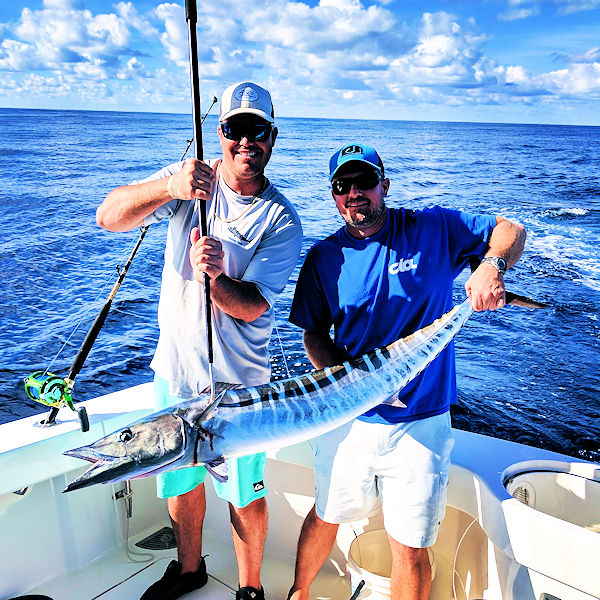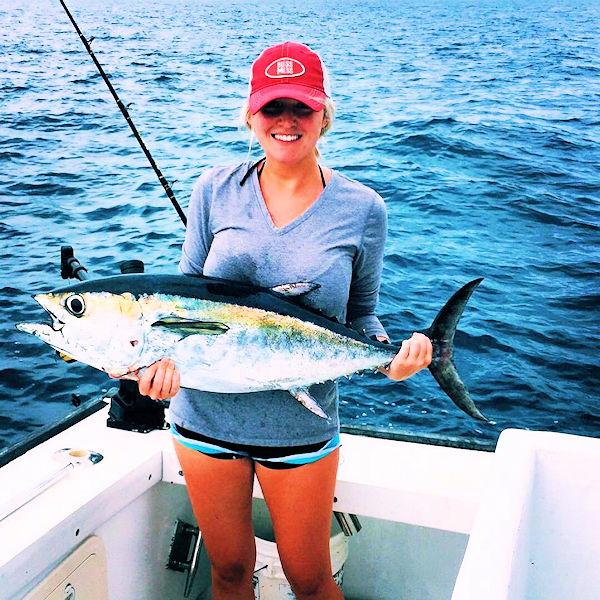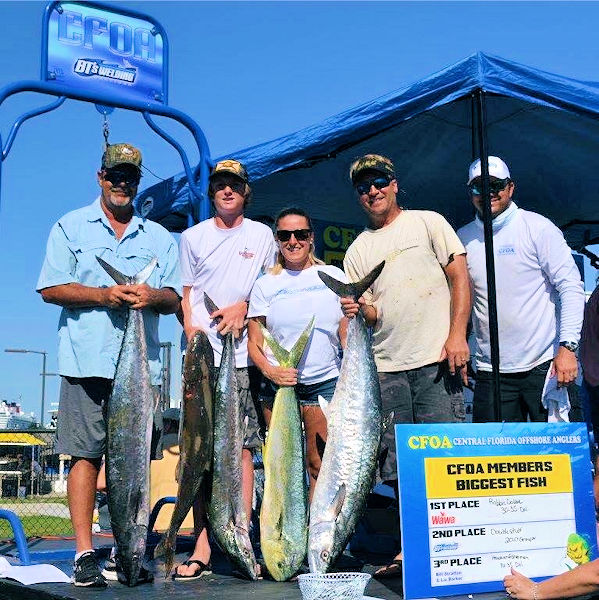Last Updated on November 5, 2024 by Eric
Alright folks—we’re in November now, and that means things are shifting out here off Port Canaveral. The air’s cooled down a little, the humidity’s eased off, and we’re seeing the water temperatures start to drop, which is exactly what we want for this time of year. While the weather has been windy and rainy, the fish are starting to move differently, more actively, and the variety of nearshore and offshore game fish you can catch in November is about as good as it gets.
If you’ve been deep sea fishing off Port Canaveral or along the rest of the Space Coast for a while, you know that November is the start of the wahoo run. These guys are showing up more and more, and if you’re looking for a shot at some fast action, they’re what you want to chase. Those of you watching the weather might have noticed some brisker winds lately, which can make things sporty on the water. But on the calmer days, it’s worth getting out there.
We’re also going to start seeing the king mackerel schooling up around the reefs and wrecks. Kings are pretty reliable in November, and if you’re trolling spoons or live bait along the right structure, they’ll keep you busy. Sailfish are also coming around more regularly now, which is another good sign.

Bottom fishing continues to hold strong, too. Grouper and snapper are still around, especially the gags and reds. They’re keeping to the deeper structures. Blackfin tuna are the wildcards this month—they’re not always around in big numbers, but when they show up, they’re ready to go—those little guys will surprise you with their fight. To add a little more to the mix, you might even find the odd mahi still sticking around near floating debris.
All in all, November’s got plenty to offer out here. You’ve got everything from the big game speedsters to steady, reliable reef fish. Just keep an eye on the forecast. We’re heading into the sweet spot of the fall season, so if you’re thinking of getting out there, now’s the time. Let’s take a look at what’s biting this month.
Port Canaveral Fish Species You’re More Likely to Catch in November
Wahoo

November kicks off prime season for wahoo. These guys are fast and powerful, which is why they’re fun to fish for—but they will put you to the test.
Wahoo tend to hang out in deeper offshore waters. You’ll be looking for spots with sharp drop-offs or any floating debris where they might be hunting.
For gear: Wire leaders and fast-trolling lures. Wahoo have teeth that’ll slice through lighter tackle, so you’ll want something tough to keep them on the line. They hit hard and run fast.
When targeting wahoo, depth is key. November’s cooler waters make them active at around 150 to 300 feet, often around ledges, drop-offs, and any kind of structure that draws baitfish. They’re known for ambushing prey, so trolling at higher speeds—around 12-14 knots—works well. Bright-colored lures like pink, purple, and blue seem to catch their eye, especially in sunlight. Some deep sea fishing charters near Orlando may also “high-speed troll” at 15 knots or more to specifically target larger wahoo.
Kingfish (King Mackerel)

November still sees kingfish migrating through the area. These fish are solid targets around wrecks and reefs. Kings can be hit on anything from trolling spoons to live bait setups, and they like to take off in short, powerful bursts. Some guys target them with stinger rigs—sharp hooks that keep them from shaking off—especially with frozen cigar minnows or live sardines.
If you’re looking for nearshore sportfishing near Cape Canaveral/Orlando with steady action, kings are reliable in November. You’ll find schools of them pretty much anywhere the baitfish are hanging out, so keep your eyes on the birds and surface activity.
Fluorocarbon leaders can help cut down on visibility, but kings also have razor-sharp teeth that can slice through lines in an instant, so some prefer to stick with wire leaders. Kings go after a variety of prey, from menhaden to cigar minnows, so live bait setups that mimic these fish work well. You’ll also see success with trolling, but be sure to vary your speed since kings often like to strike lures moving around 5-7 knots.
Kings also tend to school up, especially in the fall, which means once you find one, there’s a good chance others are nearby. They’re known for surface feeding, and a lot of captains rely on the birds to spot schools of baitfish, which kings hunt in droves. When you get into a school of kings, it’s fast-paced action, with fish after fish hitting hard and running strong.
Sailfish

Sailfish start showing up more as the waters cool. November’s cooler water temperatures bring them closer to the Canaveral coast. You’ll often spot them tailing or putting on a show, free-jumping out there, so keep an eye out.
Once hooked, they put on a full display—tail-walking, leaping, diving. It’s not just a “tug-of-war” on the line—it’s a fight, and they don’t make it easy. When one of these big guys comes out of the water, it’s something you’ll remember.
Fun Fact: When they’re actively hunting, sailfish will often “light up”—their dorsal fin extends fully, and their bodies flash with electric blue and silver hues. This happens because of specialized skin cells called chromatophores, which contain pigments that can expand and contract to reflect different colors (in this case, when they’re excited, stressed, or chasing prey). It’s a sight that never gets old and tells you they’re ready to strike.

For sails, you’ll want to rig up some live baits like goggle-eyes or threadfin herring. They are visual hunters and will take a swiped bait on sight. Slow-trolling live goggle-eyes, blue runners, or threadfin herring near weed lines or rips in the current can be effective, especially in the 100-200 foot range.
These fish are fast but can be surprisingly picky, so keeping the bait looking “alive” and natural-looking is important. Once hooked, get ready—they’ll take long, dramatic leaps and will try to throw the hook.
Grouper

Bottom fishing out of Port Canaveral stays strong in November, especially if you’re after grouper. Gag grouper are common catches around here, along with red snapper if you’re out deep enough. You’ll need heavier tackle and some patience, but these fish are worth it. Gags put up a hard fight once hooked and try to dive back to structure fast, so you’ll have to muscle them up. If you’re on a reef or wreck and you’re dropping down cut bait or live pinfish, chances are good you’ll get a bite. Just be ready to reel hard—these fish aren’t light and they aren’t giving up easy.
Red Snapper

Red snapper are particularly aggressive and are often the first to hit when you’re bottom fishing in November. They tend to stay in slightly shallower water than grouper but will still be near structure. Drop down cut bait like squid, menhaden, or pinfish to get their attention.
If there’s a good-sized school of snapper, the bite can be nonstop, but don’t forget about size limits and restrictions—these are strictly enforced, especially during red snapper season.
Blackfin Tuna

Blackfin tuna are smaller than their yellowfin cousins, but they pack plenty of power. You’ll usually find them farther offshore, especially when the water’s cooler. They’re solid fighters for their size.
Blackfin show up on radar in late fall, and by November, they’re often found in open water beyond the drop-offs and near thermal breaks or temperature changes. Look for bait schools in the 150-250 foot range and keep an eye out for birds near the surface.
Fun Fact: Blackfin tuna will often hunt alongside other pelagics, so while targeting them, you might also find mahi or even sailfish nearby.
For blackfin, trolling with small feathers, spoons, or live bait is effective. These tuna like moving fast, so anything that looks like a quick snack will catch their attention.
Other Fish Biting in November
Even though the peak mahi (dolphin fish) season is summer, you’ll still find some in November. They tend to follow debris or sargassum lines in open water. They’re strikingly colorful fish, and even though they’re around a bit less in the cooler months, if you find one, you’ll often find more.
Mahi are more of a bonus catch this time of year, but they’re a good addition if you come across a school.

While not usually a target species, bonito are frequent catches and can add a lot of action to the day. They’re not known for being picky as far as bait or lures, so they’ll hit a variety of things. Bonito pull hard, and although they’re often considered “by-catch,” they’re a reliable way to keep things fun while you wait for the bigger fish. They’re also a good way to sharpen your offshore skills if it’s your first time deep sea fishing.
Cobia will occasionally show up around reefs, wrecks, and near floating debris. Known for their power and size, cobia are opportunistic and will take a well-placed live bait if you can get it close enough.
Amberjack can sometimes be found hanging around the deeper wrecks this time of year. They’re known as “reef donkeys” because once hooked, they take off like one—testing your endurance (and your gear). You’ll usually find them around structure in 100-200 feet of water, so bottom fishing setups with live bait or jigs work best.
Techniques and Tips for November Offshore Fishing
- Trolling: November is great for trolling. Fast trolling works for wahoo and blackfin tuna, while a slower troll can bring in king mackerel or even the occasional sailfish.
- Live Baiting: For sailfish, mahi, and king mackerel, live bait works like a charm. Threadfin herring, sardines, or goggle-eyes are solid choices.
- Bottom Fishing: For those after grouper and snapper, anchoring over deep reefs or wrecks is the way to go. It’s a bit of a slower-paced method but pays off when you feel that hard hit on the bottom.
Gearing Up for Offshore Fishing
- Tackle: Go with a mix of light and heavy tackle. You’ll want heavier setups for grouper and wahoo, but you can go lighter for king mackerel, mahi, and smaller tuna.
- Bait Options: Stock up on live baits or frozen options like ballyhoo and squid. Lures like trolling plugs or flashy spoons work too—these are great for wahoo and tuna.
- Weather Watch: November can get breezy, and seas can kick up without much warning. Make sure your weather app is up-to-date, or better yet, listen to the marine forecast on the radio.
A Few Quick Pointers for Success
Start Early
Getting on the water early gives you a head start when the bite is strongest, especially with species like wahoo and kingfish that are more active in the cooler early morning hours. These fish are on the hunt at dawn, moving through their feeding grounds when the water temperature is just right.
If you’re trolling for wahoo, the first light of day can make all the difference—they’re fast and aggressive when they’re fresh off a night of feeding. Kingfish are also more likely to hit your line in the early hours, so being out there by sunrise stacks the odds in your favor.
Watch for Birds and Debris
Keep an eye out for any birds diving in the distance or for floating debris, like driftwood or seaweed patches. These are more than just surface details—they’re signs of underwater life. When you see birds diving, it often means that baitfish are near the surface, with larger game fish hunting below. Mahi and blackfin tuna are known to stick around these “fish hotels,” using the structure and shadows to their advantage. Tossing a line near these spots can bring instant action. Floating debris can hold entire schools of fish, so it’s worth approaching slowly, keeping your distance until you’ve got a clear target.
Stay Mobile
This is the time of year when fish are on the move, so don’t anchor yourself to one spot if the action isn’t happening. If you’re not getting bites, pull up and move to the next reef, ledge, or drop-off. Fish are out there looking for food, especially in November, and they’ll hit if it’s presented where they’re hunting.
Between Fall and Winter a lot of fish are in transition, following bait schools as they move, so adapting by changing locations is key. November’s active bite rewards those who stay on the move, so don’t waste precious time waiting for fish that have already moved on.
The Bottom Line
November is one of the best months for deep sea fishing in Cape Canaveral, with a wide variety of species that’ll keep you busy. Plus, the cooler weather means less sweating it out and more time enjoying the day. So let’s get out there, get some fish on the line, and make the most of the Fall fishing season!
Ready to book Port Canaveral fishing charters? Call Canaveral Kings at (321) 543-5109 or use our online reservation system to book your trip online!


